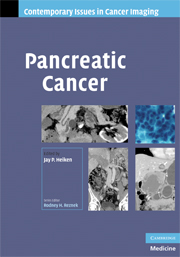Book contents
- Frontmatter
- Contents
- Series Foreword
- Preface to Pancreatic Cancer
- Contributors
- 1 Epidemiology and genetics of pancreatic cancer
- 2 Pathology of pancreatic neoplasms
- 3 Multi-detector row computed tomography (MDCT) techniques for imaging pancreatic neoplasms
- 4 Magnetic resonance imaging (MRI) techniques for evaluating pancreatic neoplasms
- 5 Imaging evaluation of pancreatic ductal adenocarcinoma
- 6 Imaging evaluation of cystic pancreatic neoplasms
- 7 Imaging evaluation of pancreatic neuroendocrine neoplasms
- 8 Role of endoscopic ultrasound in diagnosis and staging of pancreatic neoplasms
- 9 Surgical staging and management of pancreatic adenocarcinoma
- 10 Treatment of locally advanced and metastatic pancreatic cancer
- 11 Rare pancreatic neoplasms and mimics of pancreatic cancer
- Index
- Plate section
- References
2 - Pathology of pancreatic neoplasms
Published online by Cambridge University Press: 23 December 2009
- Frontmatter
- Contents
- Series Foreword
- Preface to Pancreatic Cancer
- Contributors
- 1 Epidemiology and genetics of pancreatic cancer
- 2 Pathology of pancreatic neoplasms
- 3 Multi-detector row computed tomography (MDCT) techniques for imaging pancreatic neoplasms
- 4 Magnetic resonance imaging (MRI) techniques for evaluating pancreatic neoplasms
- 5 Imaging evaluation of pancreatic ductal adenocarcinoma
- 6 Imaging evaluation of cystic pancreatic neoplasms
- 7 Imaging evaluation of pancreatic neuroendocrine neoplasms
- 8 Role of endoscopic ultrasound in diagnosis and staging of pancreatic neoplasms
- 9 Surgical staging and management of pancreatic adenocarcinoma
- 10 Treatment of locally advanced and metastatic pancreatic cancer
- 11 Rare pancreatic neoplasms and mimics of pancreatic cancer
- Index
- Plate section
- References
Summary
The term “pancreatic cancer” usually refers to ductal adenocarcinoma. While this entity accounts for 85% of primary pancreatic tumors, a variety of other neoplasms can arise from the range of cell types present in the normal pancreas (ducts, acini and islets) (Table 2.1) [1].
Ductal adenocarcinoma
Approximately two-thirds of ductal adenocarcinomas are found in the head of the pancreas. The tumor tends to be very firm and ill-defined (Figure 2.1) Cystic change (usually due to tumor necrosis) can occur but is rare [2]. This is an aggressively infiltrating cancer with a propensity for direct invasion into distal common bile duct, ampulla of Vater, duodenum, blood vessels, nerves and extrapancreatic soft tissue, particularly posterior to the pancreas.
Ductal adenocarcinoma is a gland-forming tumor. The glands tend to be round or only slightly angulated, giving the tumor a deceptively indolent appearance (Figure 2.2). There is almost always a dense stromal response to the tumor; this “desmoplastic stroma” of myofibroblasts and collagen can make it difficult to pick out the malignant cells. The glands may be lined by a single layer of cuboidal to columnar epithelium or may show complex papillary growth. Tumor nuclei usually vary in size and shape; in fact, the single most helpful diagnostic finding in a biopsy or cytologic preparation is a 4:1 variation in nuclear size within a single gland (Figure 2.3).
- Type
- Chapter
- Information
- Pancreatic Cancer , pp. 10 - 27Publisher: Cambridge University PressPrint publication year: 2008



